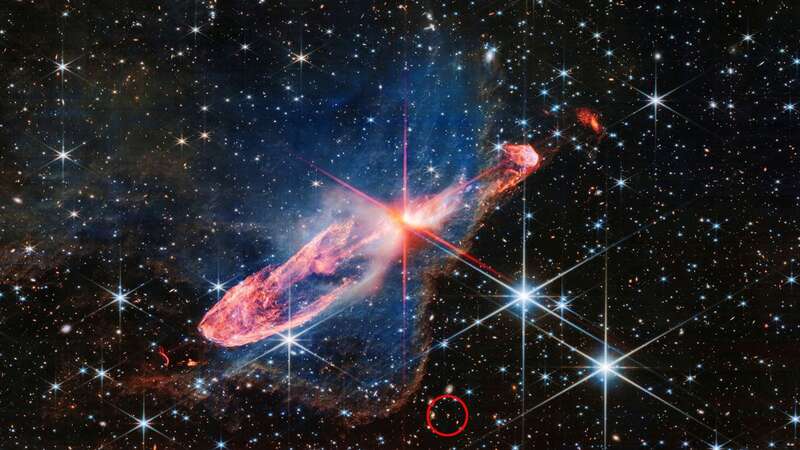
An incredible photo from space has captured the moment a baby star "screamed" for the first time.
The image - from NASA's James Webb Space Telescope (JWST) - sees sprawling red jets of gas coming from the newborn star or "protostar" in Herbig-Haro (HH) 212. The astronomical region - around 1,300 lightyears away in the constellation Orion - is only visible as infrared light.
Its appearance has been compared to a lightsaber from Star Wars. The "newborn" HH212 star is actually up to 50,000 years old, which is considered still very young in astronomical terms. The star will eventually expand to become the size of the sun in our solar system, which in comparison is around 4.5 billion years old.
Experts have been aware of HH212 for around three decades, but this new image captures unprecedented detail. Professor Mark McCaughrean, senior science advisor at the European Space Agency (ESA), said: "Our new JWST image spans six wavelengths and is 10 times sharper than any previous infrared image.
 NASA’s James Webb Space Telescope (NASA / SWNS)
NASA’s James Webb Space Telescope (NASA / SWNS)"We first discovered HH212 in 1993 using the NASA Infrared Telescope Facility (IRTF) on Maunkea in Hawaii. We've observed it many times since on increasingly large telescopes and with better and better infrared cameras and better resolution. Safe to say though, the JWST images blow all that away."
 Charming UK village is 'UFO hotspot' with 'NASA scientists showing interest'
Charming UK village is 'UFO hotspot' with 'NASA scientists showing interest'
The image is around 2.3 lightyears wide, with the protostar "hidden", and instead red "jets" and "outflows" of matter originating from it are visible. There are also "bowshocks" or waves where faster material has shunted slower material. Around the red jets are older stars and a distant galaxy.
Professor McCaughrean went on to say how, even if we could somehow visit HH212, we'd need to wear infrared goggles as the infrared light means it can't be seen by human eyes. He explained: "It's 1,300 lightyears away, so even travelling at the speed of light, it's going to have changed completely by the time you arrive."
He said comparing his image to older ones taken by the likes of Hubble show HH212 is moving "outwards from the protostar", meaning we can see the jet "expand over time". A young star ignites as dust and gas collapse under the force of gravity, before spinning and getting hotter. The leftover material forms an accretion disc and under the right circumstances could evolve to form the base material for planets, asteroids and comets.
Professor McCaughrean told the MailOnline: "Despite all this gas and dust however, we know that the protostar at the heart of HH212 is a fairly isolated, not surrounded by big dense molecular clouds. How do we know that? Because there are galaxies everywhere in this image, strewn across the image in the far distance. If there was a dense cloud, we wouldn't see them."
Read more similar news:
Comments:
comments powered by Disqus

































